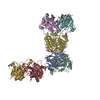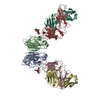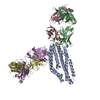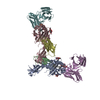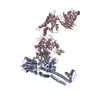[English] 日本語
 Yorodumi
Yorodumi- SASDCJ2: Solution structure of recombinant prion protein (89–230) in compl... -
+ Open data
Open data
- Basic information
Basic information
| Entry | Database: SASBDB / ID: SASDCJ2 |
|---|---|
 Sample Sample | Solution structure of recombinant prion protein (89–230) in complex with Fab-P
|
| Function / homology |  Function and homology information Function and homology informationInsertion of tail-anchored proteins into the endoplasmic reticulum membrane / negative regulation of amyloid precursor protein catabolic process / regulation of glutamate receptor signaling pathway / lamin binding / aspartic-type endopeptidase inhibitor activity / regulation of calcium ion import across plasma membrane / positive regulation of glutamate receptor signaling pathway / glycosaminoglycan binding / type 5 metabotropic glutamate receptor binding / ATP-dependent protein binding ...Insertion of tail-anchored proteins into the endoplasmic reticulum membrane / negative regulation of amyloid precursor protein catabolic process / regulation of glutamate receptor signaling pathway / lamin binding / aspartic-type endopeptidase inhibitor activity / regulation of calcium ion import across plasma membrane / positive regulation of glutamate receptor signaling pathway / glycosaminoglycan binding / type 5 metabotropic glutamate receptor binding / ATP-dependent protein binding / negative regulation of interleukin-17 production / cupric ion binding / regulation of potassium ion transmembrane transport / negative regulation of dendritic spine maintenance / nucleobase-containing compound metabolic process / negative regulation of calcineurin-NFAT signaling cascade / negative regulation of interleukin-2 production / negative regulation of T cell receptor signaling pathway / negative regulation of activated T cell proliferation / negative regulation of amyloid-beta formation / response to amyloid-beta / negative regulation of type II interferon production / cuprous ion binding / negative regulation of long-term synaptic potentiation / intracellular copper ion homeostasis / positive regulation of protein targeting to membrane / response to cadmium ion / side of membrane / inclusion body / neuron projection maintenance / positive regulation of calcium-mediated signaling / molecular function activator activity / cellular response to copper ion / positive regulation of protein localization to plasma membrane / molecular condensate scaffold activity / protein homooligomerization / protein destabilization / cellular response to xenobiotic stimulus / cellular response to amyloid-beta / terminal bouton / positive regulation of neuron apoptotic process / signaling receptor activity / regulation of protein localization / protein-folding chaperone binding / amyloid-beta binding / response to oxidative stress / protease binding / nuclear membrane / microtubule binding / molecular adaptor activity / transmembrane transporter binding / learning or memory / postsynaptic density / intracellular signal transduction / membrane raft / copper ion binding / dendrite / negative regulation of apoptotic process / protein-containing complex binding / cell surface / endoplasmic reticulum / negative regulation of transcription by RNA polymerase II / Golgi apparatus / metal ion binding / identical protein binding / membrane / plasma membrane / cytosol Similarity search - Function |
| Biological species |   Homo sapiens (human) Homo sapiens (human) |
 Citation Citation |  Journal: Biophys J / Year: 2015 Journal: Biophys J / Year: 2015Title: Prion Protein-Antibody Complexes Characterized by Chromatography-Coupled Small-Angle X-Ray Scattering. Authors: Lester Carter / Seung Joong Kim / Dina Schneidman-Duhovny / Jan Stöhr / Guillaume Poncet-Montange / Thomas M Weiss / Hiro Tsuruta / Stanley B Prusiner / Andrej Sali /  Abstract: Aberrant self-assembly, induced by structural misfolding of the prion proteins, leads to a number of neurodegenerative disorders. In particular, misfolding of the mostly α-helical cellular prion ...Aberrant self-assembly, induced by structural misfolding of the prion proteins, leads to a number of neurodegenerative disorders. In particular, misfolding of the mostly α-helical cellular prion protein (PrP(C)) into a β-sheet-rich disease-causing isoform (PrP(Sc)) is the key molecular event in the formation of PrP(Sc) aggregates. The molecular mechanisms underlying the PrP(C)-to-PrP(Sc) conversion and subsequent aggregation remain to be elucidated. However, in persistently prion-infected cell-culture models, it was shown that treatment with monoclonal antibodies against defined regions of the prion protein (PrP) led to the clearing of PrP(Sc) in cultured cells. To gain more insight into this process, we characterized PrP-antibody complexes in solution using a fast protein liquid chromatography coupled with small-angle x-ray scattering (FPLC-SAXS) procedure. High-quality SAXS data were collected for full-length recombinant mouse PrP [denoted recPrP(23-230)] and N-terminally truncated recPrP(89-230), as well as their complexes with each of two Fab fragments (HuM-P and HuM-R1), which recognize N- and C-terminal epitopes of PrP, respectively. In-line measurements by fast protein liquid chromatography coupled with SAXS minimized data artifacts caused by a non-monodispersed sample, allowing structural analysis of PrP alone and in complex with Fab antibodies. The resulting structural models suggest two mechanisms for how these Fabs may prevent the conversion of PrP(C) into PrP(Sc). |
 Contact author Contact author |
|
- Structure visualization
Structure visualization
| Structure viewer | Molecule:  Molmil Molmil Jmol/JSmol Jmol/JSmol |
|---|
- Downloads & links
Downloads & links
-Data source
| SASBDB page |  SASDCJ2 SASDCJ2 |
|---|
-Related structure data
| Similar structure data |
|---|
- External links
External links
| Related items in Molecule of the Month |
|---|
-Models
| Model #1168 |  Type: atomic / Radius of dummy atoms: 1.90 A / Chi-square value: 1.27153004943 / P-value: 0.058000  Search similar-shape structures of this assembly by Omokage search (details) Search similar-shape structures of this assembly by Omokage search (details) |
|---|---|
| Model #1169 |  Type: atomic / Radius of dummy atoms: 1.90 A / Chi-square value: 1.27153004943 / P-value: 0.058000  Search similar-shape structures of this assembly by Omokage search (details) Search similar-shape structures of this assembly by Omokage search (details) |
| Model #1167 | 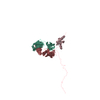 Type: atomic / Radius of dummy atoms: 1.90 A / Chi-square value: 4.55590410686  Search similar-shape structures of this assembly by Omokage search (details) Search similar-shape structures of this assembly by Omokage search (details) |
- Sample
Sample
 Sample Sample | Name: Solution structure of recombinant prion protein (89–230) in complex with Fab-P Specimen concentration: 1.00-3.70 / Entity id: 606 / 607 |
|---|---|
| Buffer | Name: sodium acetate buffer (20 mM sodium acetate, pH 5.1; 150 mM NaCl) pH: 5.1 |
| Entity #606 | Name: prion / Type: protein / Description: Major prion protein / Formula weight: 22.932 / Num. of mol.: 1 / Source: Mus musculus / References: UniProt: P04925 Sequence: KKRPKPGGWN TGGSRYPGQG SPGGNRYPPQ GGTWGQPHGG GWGQPHGGSW GQPHGGSWGQ PHGGGWGQGG GTHNQWNKPS KPKTNLKHVA GAAAAGAVVG GLGGYMLGSA MSRPMIHFGN DWEDRYYREN MYRYPNQVYY RPVDQYSNQN NFVHDCVNIT IKQHTVTTTT ...Sequence: KKRPKPGGWN TGGSRYPGQG SPGGNRYPPQ GGTWGQPHGG GWGQPHGGSW GQPHGGSWGQ PHGGGWGQGG GTHNQWNKPS KPKTNLKHVA GAAAAGAVVG GLGGYMLGSA MSRPMIHFGN DWEDRYYREN MYRYPNQVYY RPVDQYSNQN NFVHDCVNIT IKQHTVTTTT KGENFTETDV KMMERVVEQM CVTQYQKESQ AYYDGRRS |
| Entity #607 | Name: Fab-P / Type: protein / Description: P-Clone Fab, Chimera / Formula weight: 47.386 / Num. of mol.: 1 / Source: Homo sapiens Sequence: ATQAYAELVM TQTPSSLSAS LGERVSLTCR ASQDIGNNLN WIQQKPDGTI KRLIYATSSL DSGVPKRFSG SRSGSDYSLT ISSLESEDFA DYYCLQHDTF PLTFGGGTKL EIKRTVAAPS VFIFPPSDEQ LKSGTASVVC LLNNFYPREA KVQWKVDNAL QSGNSQESVT ...Sequence: ATQAYAELVM TQTPSSLSAS LGERVSLTCR ASQDIGNNLN WIQQKPDGTI KRLIYATSSL DSGVPKRFSG SRSGSDYSLT ISSLESEDFA DYYCLQHDTF PLTFGGGTKL EIKRTVAAPS VFIFPPSDEQ LKSGTASVVC LLNNFYPREA KVQWKVDNAL QSGNSQESVT EQDSKDSTYS LSSTLTLSKA DYEKHKVYAC EVTHQGLSSP VTKSFNRAYA EVQLLEQSGA ELVKPGASVK LSCTASGFNI EDSYIHWVKQ RPEQGLEWIG RIDPEDGETK YAPKFQGKAT ITADTSSNTA YLHLRRLTSE DTAIYYCGRG AYYIKEDFWG QGTTLTVSSA STKGPSVFPL APSSKAGGTA ALGCLVKDYF PEPVTVSWNS GALTSGVHTF PAVLQSSGLY SLSSVVTVPS SSLGTQTYIC NVNHKPSNTK VDKKVEPA |
-Experimental information
| Beam | Instrument name: Stanford Synchrotron Radiation Lightsource (SSRL) BL4-2 City: Stanford, CA / 国: USA  / Type of source: X-ray synchrotron / Wavelength: 0.113 Å / Dist. spec. to detc.: 1.7 mm / Type of source: X-ray synchrotron / Wavelength: 0.113 Å / Dist. spec. to detc.: 1.7 mm | ||||||||||||||||||||||||||||||||||||
|---|---|---|---|---|---|---|---|---|---|---|---|---|---|---|---|---|---|---|---|---|---|---|---|---|---|---|---|---|---|---|---|---|---|---|---|---|---|
| Detector | Name: Rayonix MX225-HE | ||||||||||||||||||||||||||||||||||||
| Scan | Measurement date: Dec 5, 2013 / Storage temperature: 4 °C / Cell temperature: 9.8 °C / Exposure time: 1 sec. / Number of frames: 10 / Unit: 1/A /
| ||||||||||||||||||||||||||||||||||||
| Distance distribution function P(R) |
| ||||||||||||||||||||||||||||||||||||
| Result |
|
 Movie
Movie Controller
Controller

